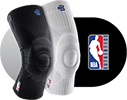Our workout videos put together by specialists to help you get active and stay injury-free.
Home Workouts with Olympian Chantae McMillan and Bauerfeind Sports
The dumbbell snatch is a dynamic exercise that strengthens the legs, back, and shoulders. Bauerfeind’s Sports Back Support and Sports Elbow Support provide sports compression for better performance and support during workouts.
1. Begin standing upright on feet spread hip-width apart and toes slightly turned out.
2. With your arm straight down in front of you, hold the dumbbell with an overhand grip. Keep your back straight, shoulders back and chest out. Your knees should stay in line with your toes with your heels planted on the ground.
3. Maintaining this posture, drop your hips down and back, dipping into a slight squat with the dumbbell between your legs.
4. Drive up through your heels to stand as you lift the dumbbell explosively up above your head. This motion should be fluid, primarily using your legs and back. Your arm should only guide the weight and press up above your head.
5. Control the weight as gravity takes it down and return to the starting position between your legs. Again, focus on maintaining an upright posture with your shoulders back, chest out, your knees in line with your toes and your heels planted on the ground.
Complete 10-15 reps before taking a rest, and repeat these sets according to your ability.
Primary muscles: Glutes, Shoulders, Core
Secondary muscles: Upper Back, Quads
About Chantae McMillan:

Chantae McMillan is a professional track and field athlete. She competed in heptathlon at the 2012 Olympics in London and is currently training for the Olympic qualifications in javelin. Over the last year Chantae incorporated more kettlebell workouts in her training and she loves it! Try her favorite exercises.



